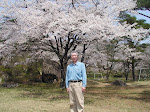
This afternoon I saw skunk cabbages come out in the marshes.
The plants are called ' 水芭蕉(Mizubashou) ' or, 'Basho in the waters', because they look like the leaves of a basho tree, a variety of banana tree that bears no fruit.
Matsuo Basho(松尾芭蕉)is said to have been named after this basho tree, because he planted it in his garden and loved the basho tree.
According to the PREFACE in The Narrow Road to Oku by Donald Keene, the name Basho was derived from a tree in his garden: in 1681, when he moved to a bleak area of the city of Edo, he planted a basho tree in order to improve the appearence of the garden. The basho, a variety of banana tree that bears no fruit, had a special meaning for poets: its broad green leaves are easily torn by the wind, a ready symbol for the sensitivity of the poet. Visitors began to refer to the place as the Basho-an (Cottage of the Basho Tree), and before long Basho was using the name for himself.
Skunk cabbages are also used to denote another plant ' 座禅草(Zazensou) ', which is similar to
' 水芭蕉' in the form or shape, but different in the color and the place where they grow.
' 水芭蕉' has green leaves and white covers for its flowers, grows in the marshes, and blooms early in summer, so it is used as the season word of summer.
' 座禅草' has purple leaves and dark purple covers for its flowers, grows in the hills or in the mountains, and blooms in spring, but it isn't used as the season word. Maybe this is because it can't be found nearby.
The similarity is that both of them look as if they sat practising zazen.
Skunk cabbages
returned to life
spring light
春光や座禅草野に生き返る
Shunkou ya zazensou no ni ikikaeru
Skunk cabbages
meditating
first zazen
水芭蕉ただ黙想す初座禅
Mizubashou tada mokusousu hatsu zazen
― Hidenori Hiruta

__I think what we refer to as -skunk cabbage- here... may be different than those you refer to. Too, another spring swamp plant we have is the Marsh Marigold, or the cowslip, some of the earliest green.
返信削除__A good haiku doublet here Hiruta San! _m
Magyar san,
返信削除Thank you very much for your nice comment.
According to A CULTURAL DICTIONARY OF JAPAN, mizu-basho is translated into English as skunk cabbage ; water banana.
But here in Akita, we called it 'Bego no shita' in our dialect in my childhood.
'Bego' means 'Cow','no' means 'of', and 'shita' means 'tongue'.
'Bego no shita' is 'Cow's tongue' or 'Tongue of cow'.
What a wonder it is that our dialect word is associated with your word 'Cowslip'!
__Oh thank you, Hiruta, for your information; I just love the commonalities... the names of such similar plants! The world keeps getting smaller in a positive way.
返信削除__Interesting: some have reasoned that life on Earth began at the cross-roads of the Tigris and Euphrates Rivers, and that that life extended through the 'million years travel' to Kashmir, then China and Manchuria and across the ice bridge to Alaska.
__At the Tigris/Euphrates there is a small boat roughly pronounced, KAI-YIK. The Eskimos of Alaska, of course, have (as do we all) their KAYAK. One wonders. _m
thanks for sharing this lovely haiku couplet; i had to google what is zazen; i thought i had a slight notion but wasn't too clear; after my reasearch, i appreciate more your twin haiku presentation in this post
返信削除much love
gillena
The translation of "cowslip" in Romanian is (botanically) "Robin boot" (robin as the bird) and it grows mainly in hilly areas and plains of prealpine. It cannot be used as a sezon word, since it grows starting from April until the end of summer, beginning of autumn. The basho tree does not exist in my country, maybe only in the botanic gardens.
返信削除skunk cabbage –
返信削除late to see bloom,
a few remain blooming